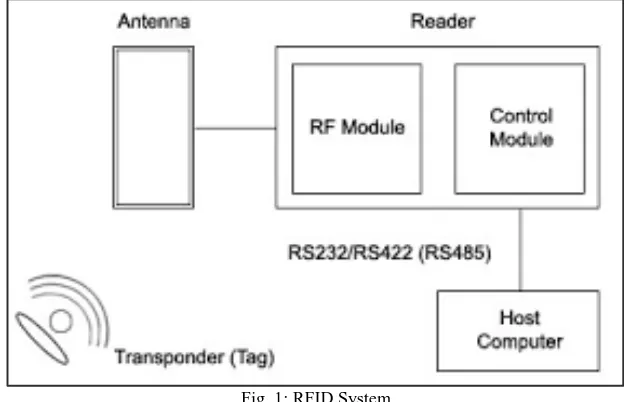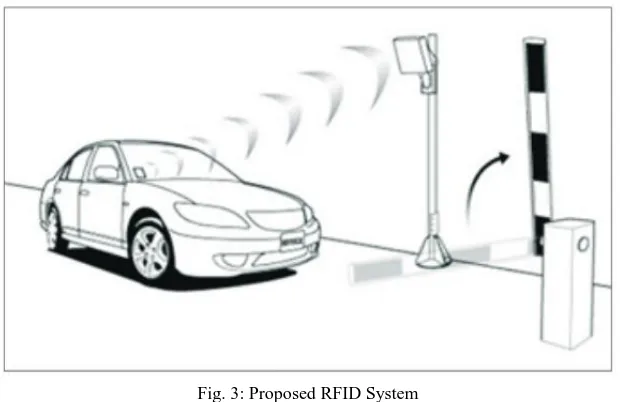RFID-Based Secured Parking Management
System
Aruna Bajpai
Assistant Professor
Department of Computer Science Engineering Institute of Technology & Management, Gwalior
Abstract
In this Paper, a solution has been provided for the problems encountered in secure parking management systems via RFID technology. Programmed RFID tags, programmed RFID readers, centralized server, barriers and image recognition software are used as for the main components of the proposed system. The software has been handled for the secure controlling, transaction reporting and operation tasks for parking located on parking zone. Vehicle Check-ins and check-outs of the parking-lots will be underneath managed with RFID readers, labels and barriers. The main focus on this paper on secure parking system and Check-ins and check-outs will be handled in a fast manner without having to interrupt the vehicles so that traffic jam problem will be avoided during these processes. Vehicle owners will not have to stop at the circulation points and parking tickets will be out of usage during check-ins and check-outs points. Vehicle owners will not have to make any payments at each check-out thus a faster traffic flow will be possible. The detail of vehicle (Number of vehicle) will stored in server through RFID system and is updated periodically into a server via network for a each user. This paper provide an idea for vehicle parking systems which automatically identifies a vehicle approaching the entrance and exit lanes to the parking facility and generates an proper set of responses such as opening the gate for valid vehicle owner and the time of entrance & exit gate.
Keywords: Automatic Control, Control Systems, Radio Frequency Identification, Tags
________________________________________________________________________________________________________
I.
INTRODUCTION
A Radio-Frequency IDentification system has three parts: A antenna, A transceiver and a transponder - the RFID tag - that has been programmed with information [1].
The scanning antenna puts out radio-frequency signals in a relatively short range. The RF radiation does two things: 1) It provides a means of communicating with the transponder (the RFID tag) AND
2) It provides the RFID tag with the energy to communicate (in the case of passive RFID tags).
Fig. 1: RFID System
All rights reserved by www.ijste.org 350 devices are built to have up to a 10 year life span, they have limited life spans. Passive RFID tags, however, do not require batteries, and can be much smaller and have a virtually unlimited life span [2].
RFID tags can be read in a wide variety of circumstances, where barcodes or other optically read technologies are useless. 1) The tag need not be on the surface of the object (and is therefore not subject to wear)
2) The read time is typically less than 100 milliseconds
3) Large numbers of tags can be read at once rather than item by item.
Like many technologies, low-cost Radio Frequency Identification (RFID) systems will become pervasive in our daily lives when affixed to everyday consumer items as “smart labels”. While yielding great productivity gains, RFID systems may create new threats to the security and privacy of individuals or organizations. In recent years, radio frequency identification technology has moved from obscurity into main stream applications that help speed the handling of manufactured goods and materials. RFID enables identification from a distance, and unlike earlier bar-code technology, it does so without requiring a line of sight. RFID tags support a larger set of unique IDs than bar codes and can incorporate additional data such as manufacturer, product type, and even measure environmental factors such as temperature. Furthermore, RFID systems can discern many different tags located in the same general area without human assistance. RFID isn’t as cheap as traditional labeling technologies, but it does offer added value and is now at a critical price point that could enable its large-scale adoption for managing consumer retail goods. The applications of Radio Frequency Identification (RFID) systems are a common and useful in manufacturing, supply chain management, and inventory control. Industries as varied as microchip fabrication, automobile manufacturing, and even deployed RFID systems for automatic object identification [3]. In this paper, author focus on the secure parking system with the help of RFID System, Server and image recognition software. A valid owner of vehicle can enter and exit the parking having a valid RFID label. It has been observed in various RFID based parking system that a unauthorized person got the RFID label and easily theft the vehicle.
II.
LITERATURE SURVEY
There are many different types of semiautomatic parking systems for vehicles such as motor vehicles including monthly pass cards, automatic ticket dispensers, and the like. In systems where time accounting is required for parking that is subject to charge periods, a card having an electronic memory is used where each memory location can be individually and irreversibly written in order to represent a time unit credit allocated to the holder of the card.
Fig. 2: Automatic Control Parking System
III.
PROPOSED SYSTEM
A vehicle will pull into an entrance lane until it can go no further because the opening gate is closed. At this point, the vehicle must be detected through a sensor emits RF signals continuously and an approaching vehicle responds. RFID reader that used includes a detector that senses the vehicle presence and notifies an entrance lane controller system that may be a separate unit or a part of a host computer [4]. The lane controller activates a sensor that sends a signal such as a radio frequency signal to the vehicle. If the vehicle owner has a valid is programmable tag (previously issued by parking management) or transponder, a signal will return from the vehicle owner to the sensor. The sensor activates the image capturing unit means camera that is elevated mounted in front of vehicle. Camera captured image of vehicle and send for image recognition tool deployed in server. After processing the image, extract the vehicle number and write the vehicle number or identification number on to the RFID tag that had in the vehicle owner and then relays that signal to the lane controller. The lane controller is a circuit that processes that signal and couples it to a host computer with specific information regarding the vehicle such as vehicle number, the date and time of day, lane number etc.
Architecture of Proposed System: A.
Fig. 3: Proposed RFID System
1) A vehicle will pull into an entrance lane until it can go no further because the entrance gate is closed
2) At this point, the vehicle must be detected. a sensor emits RF signals continuously and an approaching vehicle responds. 3) If the Vehicle owner having a valid RFID Tag.
4) RFID Reader senses the vehicle presence and notifies an entrance lane controller circuit that may be a part or separate unit of a system.
5) An elevated camera Mounted in front of Vehicle will take image of Vehicle. 6) Image will be send to server with valid RFID.
All rights reserved by www.ijste.org 352 Fig. 4: Entrance Lane Controller System
At the end of Exit lane, reverse process will be made, so the authentic user can secure the vehicle while changing the types of vehicle frequently.
IV.
CONCLUSION
This system will keeps all the information about the vehicle number, entry time, exit time and total number of parked vehicle. It may be more secure by using some other biometrics or other approaches. This paper is emphasizing on the basic architecture of secure parking system. Proposed system provides independent, non stop systems for security, parking, and access control. This technology provides businesses and communities with hands free control to ensure only authorized vehicles have entry.
REFERENCES
[1] D.L. Almaza et al, “Design and implementation of vehicular access control using RFID”, MEP 2006, Guanuato, Maxico, PP 223-225.
[2] B. Glover, & H. Bhatt, RFID Essentials, O’Reilly Media,Inc, Sebastopol, (2006), ISBN 0-596-00944-5.
[3] Higgins,N.,L.,Cairney,T.,2006., RFID opportunities and risks. Journal of Corporate Accounting & Finance, Vol,17 (5):51-57.
[4] Pala, Z., 2007, Automation with RFID Technology as an application: Parking Lot Circulation Control(MSc), Yuzuncu Yil University,Van.
[5] Steve Lewis, “A Basic introduction to RFID”
[6] R.Ranjini1, D.Manivannan2, A Comparative Review on Car Parking Technologies presented at International Journal of Engineering and Technology
(IJET)
[7] www.rfidjournal.com
[8] Roussos, G., 2008. Networked RFID systems, software and services.springer.
[9] Wei Liu et all., RFID Applications in Assets and Vehicles Tracking, The internet of things, Auerbach Publications Taylor & Francis Group 2008.
[10] Gurjot Singh Gaba, Nancy Gupta, Gaurav Sharma, Harsimranjit Singh Gill, “Intelligent Cars using RFID Technology”, International Journal of Scientific



